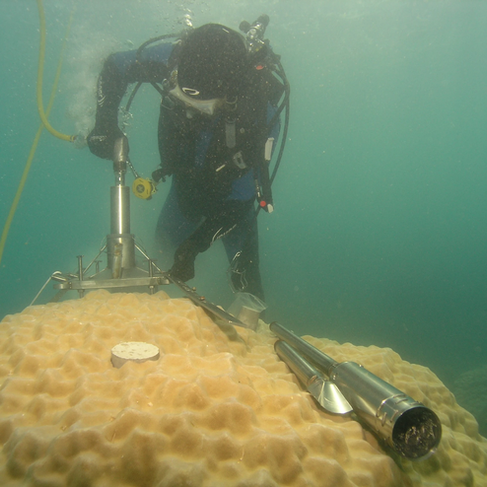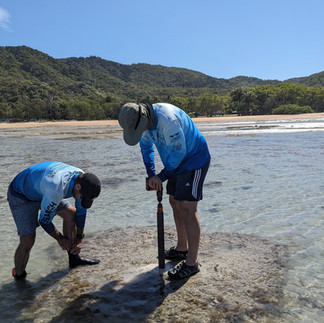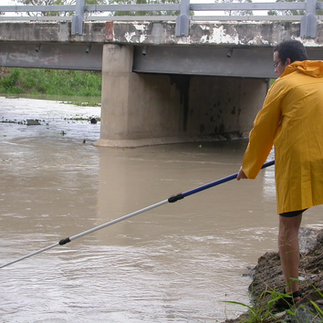A history of the Great Barrier Reef with Dr Stephen Lewis
- emmarehn5
- Apr 8
- 9 min read
Updated: May 13

As part of the newly-launched Water Quality Science & Agriculture Hub, Dr Stephen Lewis delves into the history of the Great Barrier Reef, tracing its development over the past 7,000 years and exploring the complexities of establishing a baseline for assessing its health. He examines how scientists use geological and coral records to measure the reef's health over centuries and millennia, shedding light on how the frequency of disturbances like river runoff and coral bleaching has increased in recent times.
There are several reasons that motivate me to do my research. Mostly it is to quantify what has changed in our local region over the longer term and to share this knowledge with others. For the Great Barrier Reef, that means exploring one of my favourite topics: long-term environmental and climate records. These records help us build a baseline of the Reef’s natural variability.
But how do we establish a starting point to measure its health? The answer is more complex than it seems.
Let’s think about climate change
Scientists have grappled with measuring changes to environmental health for years. Let’s think about this in terms of climate change research. We know the climate is changing rapidly, and to understand future impacts, scientists look to the distant past. We also know that rapid climate shifts have happened before, some leading to mass extinctions – and some of those ancient events are used to downplay today’s climate crisis.
But is it valid to compare climate changes from over 10 million years ago to what’s happening now?
Modern humans have only been around for 300,000 years – a blink in Earth’s 4.6-billion-year history. Our ancestors lived through major sea-level changes, including five ice ages and six interglacial periods. But the rate of today’s change is faster than anything they experienced.
So where should we draw the baseline? A human lifetime of 80 years? The 300,000 years of modern human history? The 66 million years since mammals took over? The 580 million years of complex life? Or the full 4.6 billion years of Earth’s story? I honestly don’t know the best answer for climate change, but it does give us great context for measuring the baseline health of the Great Barrier Reef.
Seven thousand years young: how old is the reef?
So let’s get back to the Great Barrier Reef - how far back should we go to assess the Reef’s current health and future prospects against a long-term baseline? When should we start comparing its recovery and disturbance patterns – like shifts in seawater temperatures, sea-level changes, cyclone intensity and frequency, terrestrial runoff and exposure to sediment and nutrient loads, and crown-of-thorns starfish outbreaks?
To answer that, we first need to consider the Reef’s history. The Great Barrier Reef has been in existence for the past 800,000 years. The ‘modern Reef’, as we know today, has only been in place for the past 7,000 years. That’s only about 1 percent of that time.
Sea level during the last ice age, around 19,000 years ago, was 125 metres lower than today. This means Australia’s coastline was about 50 to 100 km further offshore. The inshore Great Barrier Reef we know today didn’t exist. It was part of a large floodplain. Back then, the Great Barrier Reef was a thin veneer – a much smaller, narrow strip of reefs growing along the outer edge of the continental shelf.
With the melting of the ice sheets, sea-level rose from -125 m to reach present levels around 7,500 years ago. This coincides with when most of the coral reefs of the middle and inner shelf began growing about 7,000 years ago. Coral reef accretion – their growth vertically and laterally – peaked 5,000–6,000 years ago before slowing around 4,000 years ago as most reefs reached sea level and sea levels fell by around 1 m. To put it simply, coral reefs grew quickly to use the best space available and then accretion rates have slowed or even ceased at some sites.
This natural shift suggests a 4,000-year baseline for assessing reef health, as it reflects the conditions under which today’s Reef ecosystems evolved –making it a more relevant point of comparison than deeper geological history.
Great Barrier Reef monitoring dates back 40 years – how can we go beyond that timeline?
There are two large scale monitoring programs that use systematic and reproducible methods to gauge the health of the Reef that allow trends in condition to be evaluated.
The Long Term Monitoring Program run by the Australian Institute of Marine Science mostly focuses on the mid and outer reefs of the Great Barrier Reef commenced around 1986.
The Marine Monitoring Program run by the Great Barrier Reef Marine Park Authority that focuses on seagrass meadow and coral reef health of the inshore Great Barrier Reef started in 2005.
Both of these monitoring programs show disturbances are occurring more frequently, leaving less capacity for recovery. But do we only have “the data” to properly benchmark reef condition trends over the past 20 to 40 years?
While these datasets are highly valuable, we need to draw on geological records to build a longer baseline to understand a more complete picture of how the Reef has changed over time and what lies ahead.
Coral cores, growth rings, and rubble – how we uncover evidence
Now I can come back to my favourite topic – foundational records of climate and environmental change. By studying geological and natural records like coral growth rings, coral rubble, and reef cores, we can find evidence that show when and how often disturbances happened over much longer periods – and in some cases we can date this back 7,000 years.
This extends our baseline back much further than a few decades.
So, let’s consider these disturbances and the methods we can use to investigate how they have changed beyond our monitoring data, to go back hundreds and even thousands of years.
Seawater temperatures and coral bleaching
Coral bleaching is a stress response where a coral expels its zooxanthellae. It can be triggered by unusually warm or cold seawater temperatures, low salinity or other environmental stressors. Not all bleached corals die. While severely bleached corals can die and some reefs do not fully recover to their former state – many have the ability to recover if conditions improve.
Historical records provide evidence that bleaching at individual or a small cluster of reefs has likely always occurred. But mass coral bleaching events – where bleaching of a large proportion of corals occur across multiple coral reefs – appears to be a relatively recent phenomenon.
It was first recorded globally in the strong El Niño of 1983/84, and for the first time in the Great Barrier Reef during the strong 1997/98 El Niño. Since then, the Great Barrier Reef has endured six mass coral bleaching events (2002, 2016, 2017, 2020, 2022, 2024) – each linked to abnormally warm seawater temperatures that persist over several weeks.
So how do we know that mass bleaching linked to elevated seawater temperatures is a recent phenomenon, especially when monitoring only dates back to the 1980s? How can we measure past seawater temperatures before reliable instrument measurements were available?
This is where we look at coral skeletons. Here scientists can use the chemistry of coral skeletons to quantify the seawater temperatures over much longer periods. Massive corals lay down annual growth rings similar to trees and we can use trace elements such as strontium and uranium in these skeletons to reveal past seawater temperatures. By counting coral growth rings or using dating methods like radiocarbon or uranium-series, and analysing the skeleton’s chemistry, we can reconstruct past seawater temperatures from long before instruments existed.
A recent study used this method on a number of coral core records dating back 400 years and showed that seawater temperatures today are much higher than what they have been over that period. Longer records suggest that seawater temperatures are the highest they have been for at least 20,000 years.
More research is required to produce coral reef temperature records that extend further back over the past 7,000 years, although it appears the seawater temperatures are changing faster than what reefs of the past have experienced.
Records of tropical cyclone frequency and intensity
The Great Barrier Reef holds natural records of past cyclones – like coral rubble piled behind beaches or tossed onto reef flats. Even cave formations (speleothems) on the Atherton Tablelands have captured cyclone history through their chemical makeup.
Tropical cyclones can break up coral reefs with large waves. Storm surges then push the broken pieces onshore, forming coral rubble ridges like sand dunes, but made instead of coral fragments. Scientists measure their height and date the fragments to learn about past storms. This tells us when the cyclone occurred and how intense the cyclone was – the more intense the higher the ridge. The records point to the presence of ‘super cyclones’ in the period between 4,000 and 6,000 years ago. Indeed, the past 1,000 years is thought to be a ‘lull period’ for large tropical cyclones.
Crown of thorns starfish outbreaks
The Great Barrier Reef has now endured four recent waves of destructive crown of thorns starfish outbreaks since the 1960s. The outbreaks of crown of thorns greatly reduce coral cover over a reef and the frequency of these recent outbreaks occurs every 12 to 15 years.
While the specific cause of these outbreaks is still subject to debate and under investigation, it is thought outbreaks have become more frequent in recent times. Some scientists believe the increase is due to more food (plankton) from increased nutrients, and others that it is due to less natural predators (such as the triton snails). Both hypotheses may be correct.
When crown of thorns starfish die they leave behind small spicules (like a skeleton) that become buried in the reef structure. Sediment cores from coral reefs reveal layers that are indicative of historical outbreaks. This evidence shows crown of thorns starfish outbreaks have occurred in the Great Barrier Reef over the past 6,000 years, although the evidence for the frequency of these historical events is lacking.
River discharge and terrestrial runoff
The growth rings of the massive corals provide other useful measures of climate and environmental variability, including river discharge and terrestrial runoff. When a coral slice is illuminated under a UV light, thin yellow lines of varying intensity glow from the skeleton. The intensity of these individual lines are directly correlated with the volume of river discharge from the adjacent river catchment. Hence, we can use these coral records as a river gauge to quantify river discharge over hundreds of years. This has been done for the Burdekin River where we can extend the river discharge history back to 1648 CE. Data show that the biggest flow events (top 10%) for the Burdekin River have increased over time. From 1650–1850, they were about 10–12 million ML. This rose to 17 million ML from 1850–1950, and 22 million ML from 1950–2012. The increase in the volume of these large flow events means that river plumes carrying terrestrial pollutants are likely to extend further into the Great Barrier Reef lagoon. Further, the frequency of these large discharge events has increased. From 1650–1850, they occurred about once every 14–20 years. That changed to once every 7 years (1850–1950), and once every 6 years (1950–2012). So, floods have become both larger and more frequent. Discharge over the extreme 2010–11 season was likely the biggest freshwater discharge to the Great Barrier Reef in over 500 years.
The chemistry of the coral skeleton also reveals changes in sediment loads discharged to the Great Barrier Reef as a result of land use changes in the adjacent river catchments. The corals are ‘seeing and recording’ the influence of increased terrestrial runoff. Findings emerging from the Marine Monitoring Program show that terrestrial runoff including freshwater, sediments and nutrients are impacting the condition of coral reefs and seagrass meadows within the inshore Great Barrier Reef.
Furthermore, the findings also show that good water quality is paramount for marine ecosystems to recover quickly from disturbance events. Data from the Long Term Monitoring Program of the mid and outer shelf coral reefs currently show faster recovery of coral cover relative to their inshore counterparts partly because of better water quality conditions.
Summary
Geological records provide incredible insights into the Great Barrier Reef, clearly showing the Reef is experiencing disturbances at much greater frequency than it has done for at least the past 500 to 1,000 years. It’s unclear if this is unprecedented over the past 4,000 to 7,000 years – that’s what motivates much of my research.
With rising sea temperatures, larger floods, stronger cyclones, and threats like ocean acidification, disturbance frequency is likely to increase. The current observations from monitoring programs suggest that the condition of marine ecosystems have been ramping down over the past decade or so. It’s not all bad news though. Evidence is emerging there are some ‘fortunate reefs’. While coral reefs are declining, some reefs sit in cooler, more sheltered waters. Management efforts like crown of thorns starfish control, restoration, and water quality programs aim to ease pressure and give the Reef a better chance to recover.
Time will tell whether these interventions are enough but at least we have some hope in trying. Image credits: Eric Matson, AIMS; Ido Fridberg, JCU; Dr Emma Ryan and Emily Lazarus.



















